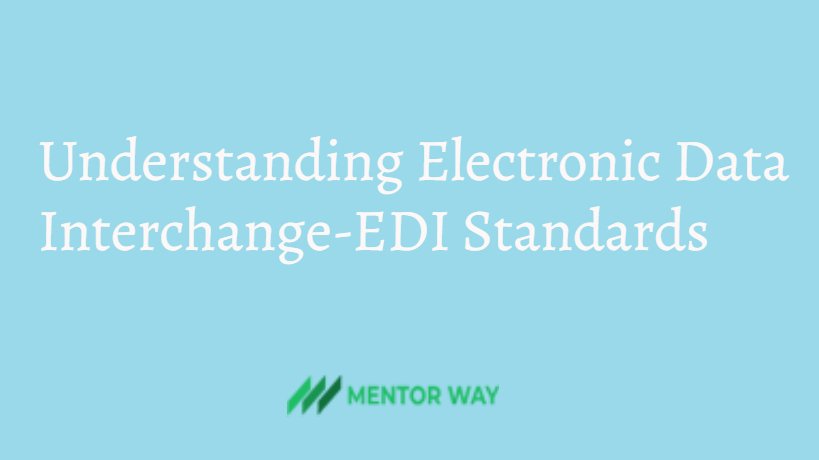Understanding Electronic Data Interchange-EDI Standards

When e-business started, the need for common standards was felt as there were many different types of computer systems and different ways of storing data.
Since the sender and receiver in the EDI systems had to exchange business documents that could be interpreted by all parties, it became necessary to develop standards in EDI. Many independent or industry-specific standards were developed to address the requirements of each industry segment.
But, a large number of businesses operated across various industry segments. Thus, the cross-industry standards were required to provide smooth functioning of EDI systems. Over a period of time, two major EDI standards have evolved.
- The first one is x12 which was developed by the Accredited Standards x12 committee of the American National Standards Institute (ANSI).
- The second international standard was developed by the United Nations EDI for Administration Commerce and Trade (EDIFACT).
EDI standards need these basic components:-
- A syntax for message which specifies the structure and sequence of elements in the data. Just as syntax in a language defines where to place the subject, verb and object in a sentence, similarly EDI syntax defines where to put things like the sender’s address, date and time, reference number and other such values.
- An encoding scheme to identify the character set being used.
- A data dictionary that defines the standard business data elements such as sender, product code, address, currency, etc.
- Combinations of data elements to be used for standard messages.
ANSI X12:-
The Accredited Standards Committee (ASC) X12 was set up by the American National Standards Institute (ANSI) in 1979 to develop cross county standards for exchanging electronic document for use by all businesses in the United States.
The committee developed ANSI ASC X12 , commonly referred to as the X12 standard. Today, EDI standards are firm but not static because the development of EDI is a continuing effort.
The X12 standard sets the framework and rules for electronic data interchange. It describes the format for structuring the data, the types of documents that should be transmitted electronically, and the content of each document.
The identification numbers for various forms, codes for a variety of fields, and types of information are also defined in the standard. The standard also defines the sequence of the information flow.
The ANSI ASC EDI standard the data structure and content for business transactions transmitted between computer applications. The data is grouped to represent all the information required for a particular business function, such as a purchase order.
The X12 standard defines a set of documents referred to as transaction sets, for a wide range of business transaction forms. Each transaction is given a numeric code, and each transaction set is used for defining the transfer of a single document (purchase, order, manifest etc.) between the computers of two trading partners.
The data embedded in a transaction set conveys the same information that is contained in the printed version of the document.
Usually, it is a subset of the whole information on the printed version.
The X12 devised the standard to data with transactions such as purchase order placements, order processing, shipping, invoicing, payment, and cash application processing for products and services.
In the X12 standard, paper documents related to particular business activities are mapped into a transaction set. It assigns a numeric code to each of these transaction sets in a manner very similar to the numbering of business forms allowed at many organizations.
Examples of ANSI ASC X12 transaction include:-
- Vendor Registration (form no. 838)
- Request for Quotation (form no.840)
- Response to request for Quotation (from no. 843)
- Purchase Order or Delivery Order (form no. 850)
- Purchase Order Acknowledgement (form no.855)
- Functional Acknowledgement (form no. 997)
EDIFACT- An International Standard:-
In 1987, the United National announced an international standard called Edi for Administration, Commerce, and Transport (EDIFACT). The EDIFACT standard is promoted by the United Nations Economic Commission, which is responsible for the adoption and standardization of messages.
The International Standards Organization (ISO) has been entrusted with the responsibility of developing the syntax and data dictionary for EDIFACT.
EDIFACT serves the purpose of trans-border standardization of EDI messages.
EDIFACT combines the efforts of American Nation Standards Institute’s ASC X12, Trade Data Interchange (TDI) standards developed and deployed by much of Europe and United Kingdom.
It is a set of internationally agreed upon standards, directories and guidelines for the electronic interchange of structured data that relate, in particular, to trade in goods and services .
It consists of data elements (a value), segments (a logical group of data elements), and messages (a collection of segments relating to a business function), and rules for combining them.
Each data element has attributes such as:
- Coded tag or identifier (code dictionary)
- Title
- Plain text description
- Format (length and data type or class)
- Year of insertion in Directory, along with previous issue in parenthesis.
EDIFACT is becoming widely accepted as the foremost international EDI standard. Today, EDIFACT and ANSI are working towards compatibility.



